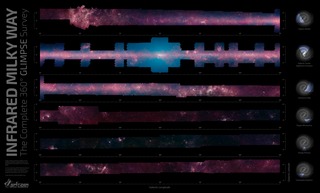
Credit: NASA/JPL-Caltech/GLIMPSE Team
Observation • March 20th, 2014 • ssc2014-02a1
ssc2014-02a1
Each of these panels shows 60 degrees of Spitzer's new 360-degree infrared view of our Milky Way Galaxy. The full 360-degree mosaic comes primarily from the GLIMPSE360 project, which stands for Galactic Legacy Mid-Plane Survey Extraordinaire. It consists of more than 2 million snapshots taken in infrared light over ten years, beginning in 2003 when Spitzer launched.
This infrared view reveals much more of the galaxy than can be seen in visible-light views. Whereas visible light is blocked by dust, infrared light from stars and other objects can travel through dust to reach Spitzer's detectors. For instance, when looking up at our night skies, we see stars that are an average of 1,000 light-years away; the rest are hidden. In Spitzer's mosaic, light from stars throughout the galaxy -- which stretches 100,000 light-years across -- shines through. The full 360-degree picture covers only about three percent of the sky, but includes more than half of the galaxy's stars and the majority of its star formation activity.
Blue stars seen in these images are relatively close to us, while the red color shows dusty areas of star formation. Throughout the galaxy, tendrils, bubbles and sculpted dust structures are apparent. These are the result of massive stars blasting out winds and radiation. Stellar clusters deeply embedded in gas and dust, green jets and other features related to the formation of young stars can also be seen for the first time. Dark filaments that show up in stark contrast to the bright background are areas of thick, cold dust that not even infrared light can penetrate.
This panel shows the Galactic Center, stretching from 330 to 30 degrees in galactic longitude, covering the constellations of Sagittarius and Scorpius. The blue haze that permeates this image is starlight from mature stars, which are packed together so densely that we cannot pick them out individually.
For the full resolution view of this image, see http://www.spitzer.caltech.edu/glimpse360/downloads. (Warning: these files are very large - approximately 600mb - 1gb each)
About the Object
- Name
- Milky Way
- Type
- Galaxy
Color Mapping
| Band | Wavelength | Telescope |
| Infrared | 3.6 µm | Spitzer IRAC |
| Infrared | 4.5 µm | Spitzer IRAC |
| Infrared | 8.0 µm | Spitzer MIPS |
Astrometrics
- Position ()
- RA =0h 0m 0.0s
- Dec = 0° 0' 0.0"
- Field of View
- 60.0 x 10.0 degrees
- Orientation
- North is up










